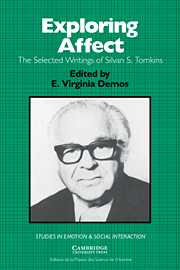Book contents
- Frontmatter
- Contents
- Foreword
- Editor's preface
- List of contributors
- Chronology
- Introduction
- Part I Affect theory
- Introduction
- Selections by Silvan S. Tomkins
- Part II Affect and ideology
- Introduction
- Selections by Silvan S. Tomkins
- Part III The face of affect
- Introduction
- Selections by Silvan S. Tomkins
- Part IV Script theory: The differential magnification of affect
- Introduction
- Selections by Silvan S. Tomkins
- Part V Human being theory: A foundation for the study of personality
- Introduction
- Selections by Silvan S. Tomkins
- The cognitive system
- Simulation of personality: The interrelationships between affect, memory, thinking, perception, and action
- Personality theory and social science
- A complete annotated bibliography of Silvan S. Tomkins's writings
- References
- Author index
- Subject index
- Titles in the series
Simulation of personality: The interrelationships between affect, memory, thinking, perception, and action
Published online by Cambridge University Press: 10 November 2010
- Frontmatter
- Contents
- Foreword
- Editor's preface
- List of contributors
- Chronology
- Introduction
- Part I Affect theory
- Introduction
- Selections by Silvan S. Tomkins
- Part II Affect and ideology
- Introduction
- Selections by Silvan S. Tomkins
- Part III The face of affect
- Introduction
- Selections by Silvan S. Tomkins
- Part IV Script theory: The differential magnification of affect
- Introduction
- Selections by Silvan S. Tomkins
- Part V Human being theory: A foundation for the study of personality
- Introduction
- Selections by Silvan S. Tomkins
- The cognitive system
- Simulation of personality: The interrelationships between affect, memory, thinking, perception, and action
- Personality theory and social science
- A complete annotated bibliography of Silvan S. Tomkins's writings
- References
- Author index
- Subject index
- Titles in the series
Summary
Many years ago, in the late 1930's, I was seized with the fantasy of a machine, fearfully and wonderfully made in the image of man. He was to be no less human than auto-mated, so I called him the humanomaton. Could one design a truly humanoid machine? This would either expose the ignorance or reveal the self-consciousness of his creator or both.
Such an exercise can be as exciting as it is instructive if it is undertaken in the spirit of play. At the worst it is a harmless conceit. But excitement and the delight of play are not the only affects evoked by such a fantasy, and it would be well at the outset of a conference on computer simulation to recognize the full spectrum of human responses to the idea of man creating a machine in his own image.
The machine itself, apart from the machina ad hominem, has evoked every variety of human response. It has seemed benign as well as malignant, as often an object of indifference as an object of pride, the servant of man and sometimes his master, stupid or clever, dynamic as well as static. There have been as many images of the machine as of the gods. It is because the machine lends itself to such idealization that the relation between man and machine becomes electric when man takes himself as a model for a machine to be built in his own image.
- Type
- Chapter
- Information
- Exploring AffectThe Selected Writings of Silvan S Tomkins, pp. 441 - 467Publisher: Cambridge University PressPrint publication year: 1995
- 1
- Cited by



